The Pyramid of Djoser
Imhotep was the first and most famous master builder of ancient Egypt.
He is considered one of the earliest polymaths in the history of humanity, which means someone of wide-ranging knowledge.
The fact that Imhotep's face was engraved in a Pharaoh's statue is a testament to his importante - one of very few common men who were granted divine status after death.
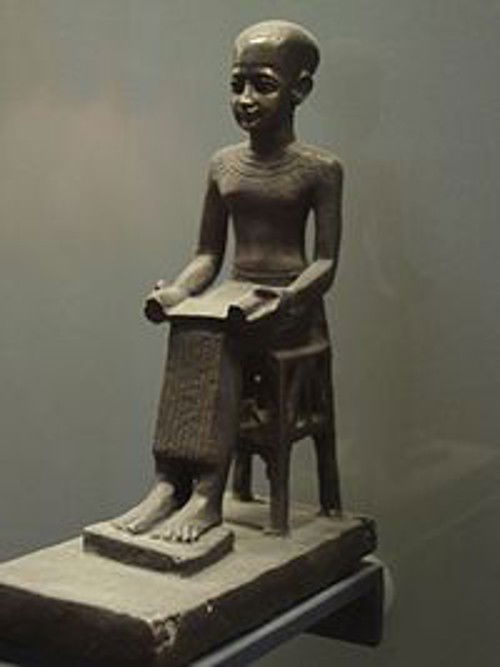
Imhotep is said to have been responsible for building the very first pyramid in Egypt — the Pyramid of Djoser in Saqqara. Imhotep was one the main advisors to pharaoh Djoser, and the pyramid was built during his 3rd Dynasty.
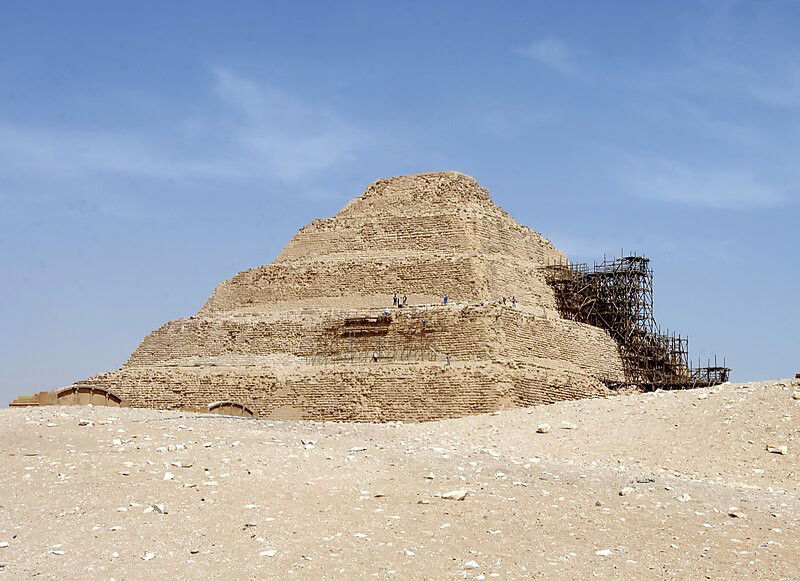
Inspired on this important architect, engineer and even physician, let's play Imhotep!
Imhotep - Game Info
Imhotep is a 2-4 players game, age 10+, created by designer Phil Walker-Harding. The game's art is by Miguel Coimbra and Michaela Kienle.
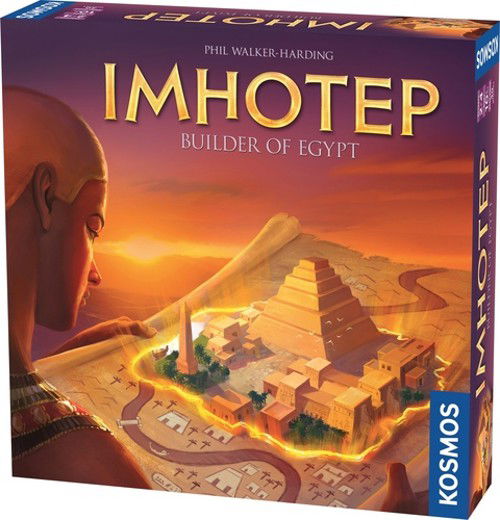
Imhotep was released in 2016 by KOSMOS. The main game mechanics involve: resource management, positioning of pieces, planning ahead and numeric advantage.
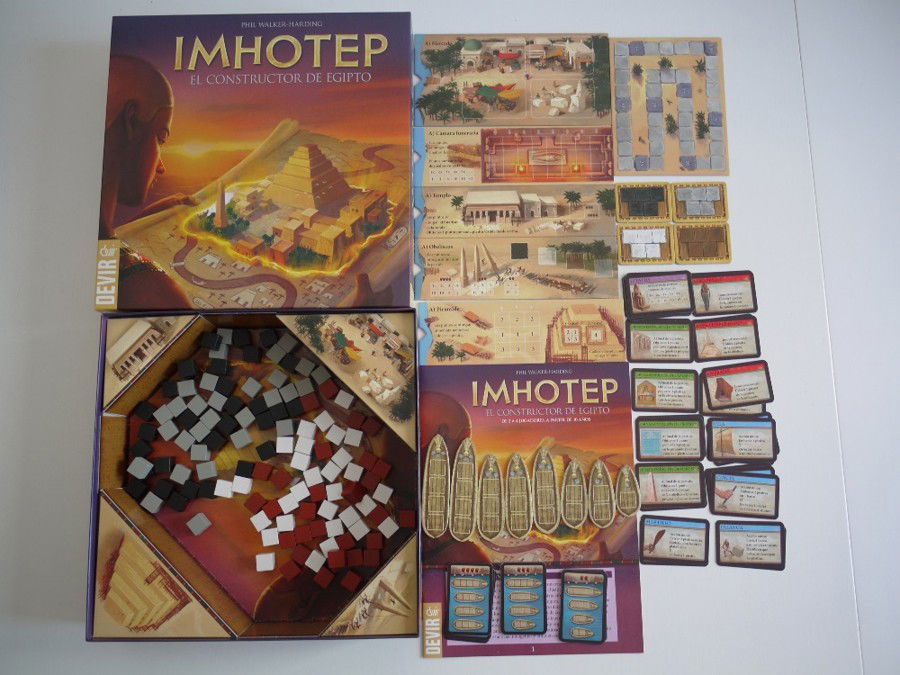
Since its release, Imhotep has received numerous awards. In 2016 it won the Fall Parents' Choice Gold Award, and in 2017 it won the Boardgames Australia Awards for best game. It has also received several nominations, including: Golden Geek, Meeples Choice Award and the Spiel des Jahres.
Let's play!
The Game
Like Imhotep, we'll build something that'll last for ages. Let's collect stones, transport them to the ships - which, by the way, are shared with other master builders who compete with us to build monuments. We don't always define the destinations of the ships and, as a result, our stones may end up in a building that we don't want. To prevent this, find the perfect timing for the transports - and guarantee your place in history.
This is the background for Imhotep!
Beginning the game, each player will have a sled to transport stones. The first player receives 2 stones on their sled; the second player receives 3 stones; and so on.
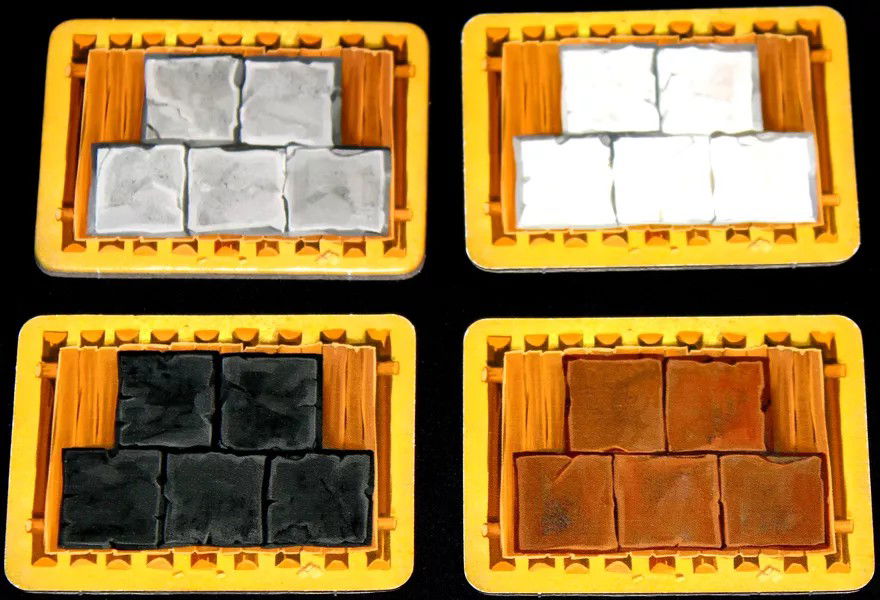
The remaining stones are placed in the Stone Quarry. At this point, it is revealed which ship and what capacity will be available to take the stones to the 5 available locations. Setup is complete!
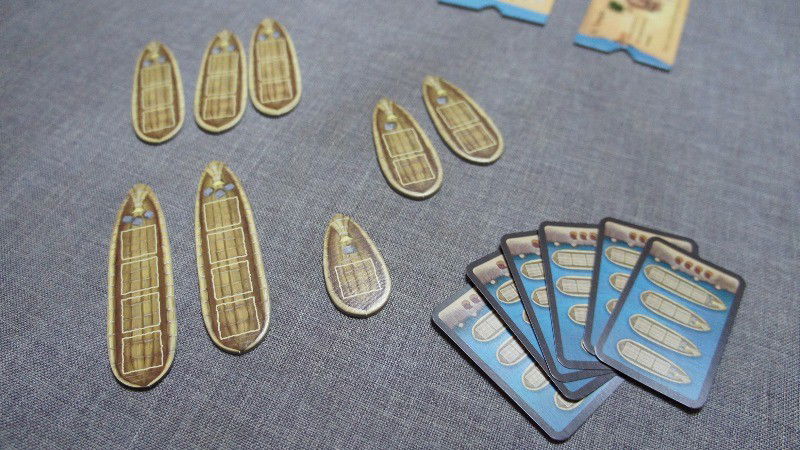
On your turn, you can do 1 of 4 possible actions:
If you choose the first action, you receive 3 stones from the Stone Quarry and place them on your sled. Remember, no stones means no monuments!
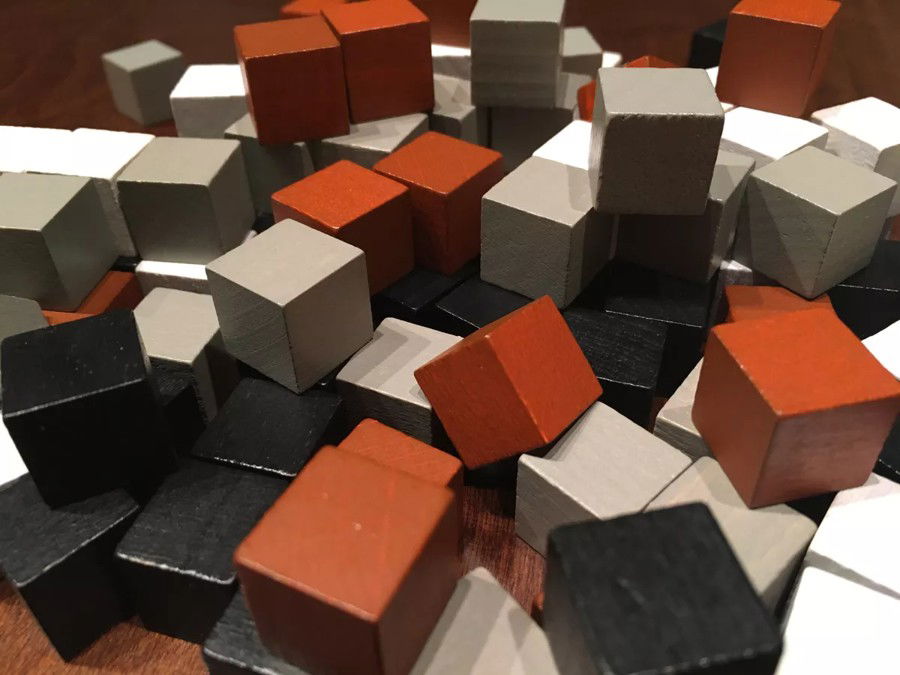
The second action, placing 1 stone from your sled on a ship, is crucial, since it is the only way to ensure that your stones will get to one of the 5 available sites.
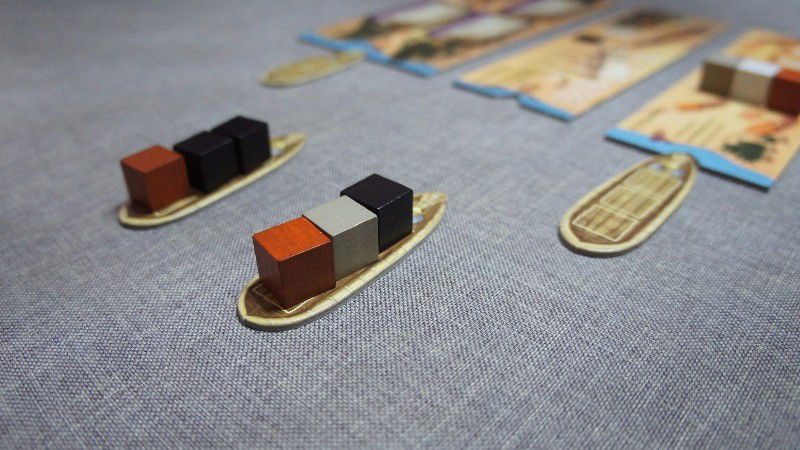
The third action is perhaps the most anticipated one, which is sailing 1 ship to an available site. It's a strategic move, because any player can perform this action - you can load your stones to a ship and, later, take these stones to the pyramid; however, another player can, on their turn, take this ship to the obelisks and tamper with your strategy. This is certainly a spiteful move by an opponent.
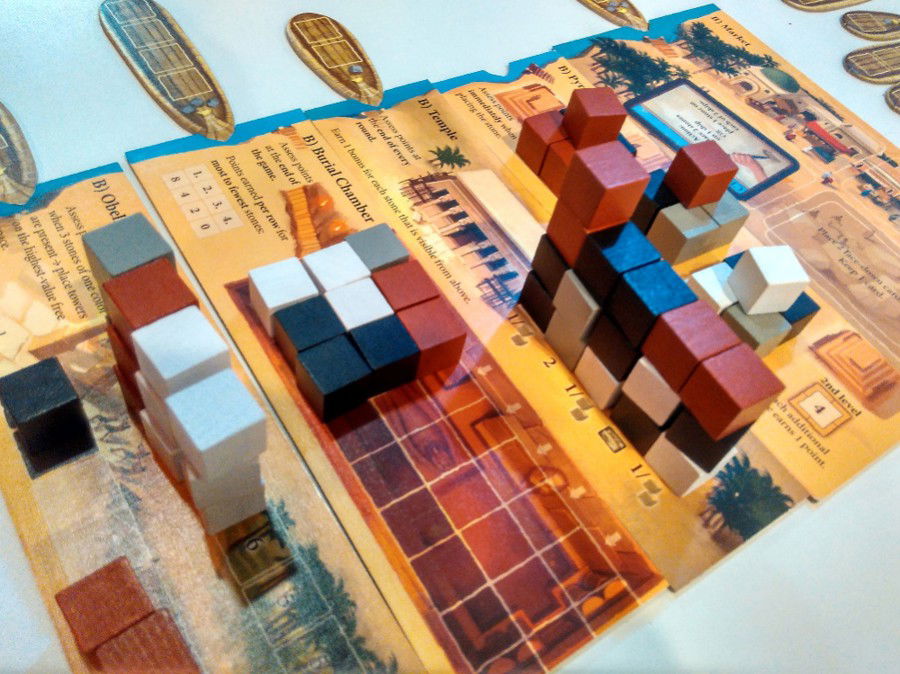
The five different sites to sail ships to are:
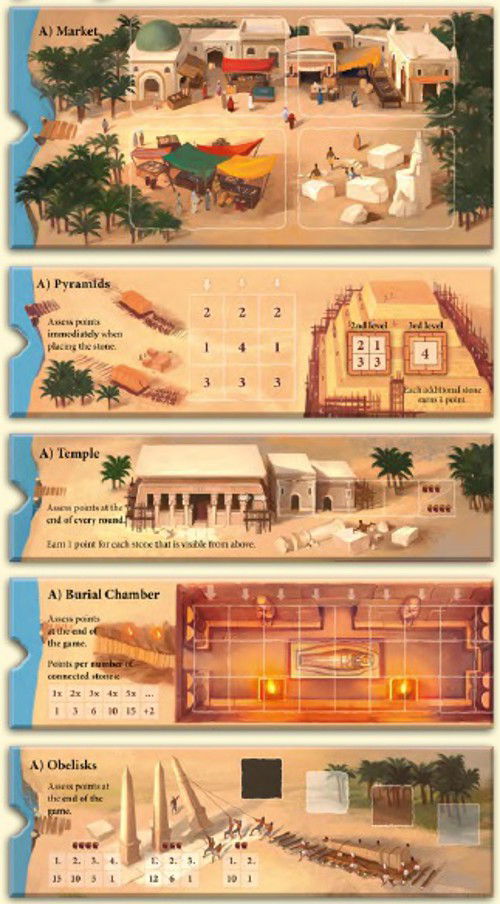
The last possible action is to play a Blue Market Card. They are really powerful, since they perform all different sort of effects - don't forget about them!
Here is a brief explanation about the 4 types of cards available:
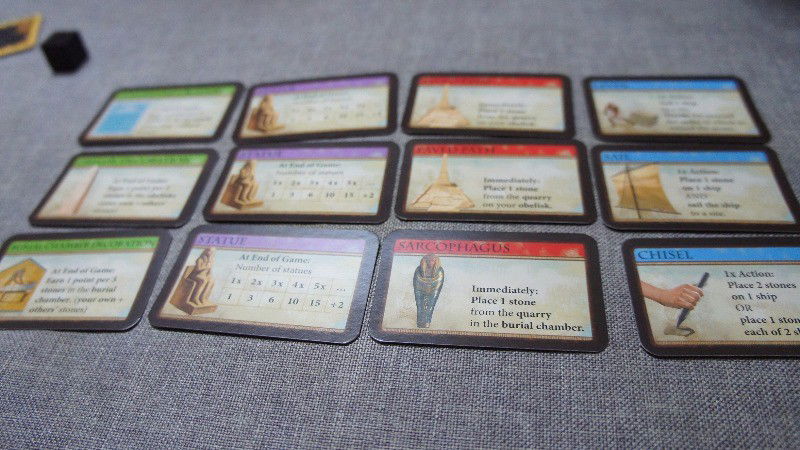
After taking your turn, play continues with the player to your left, and so on until all four ships sail to an available location. This marks the end of a round. After this, award points according to the Temple stones, draw a new Round Card - showing which ships will be available -, and so a new round begins!
This is how you play a round of Imhotep!
Ending the Game
The game ends after six rounds. Afterwards, award the final points, with the corresponding advancement in the Scoring Track Board:
Whoever has the most points is the winner! In case of a tie, the player with the greater number of stones on their supply sled token is the winner. If this is also a tie, the tied players share first place.
Strategy Tips
The strategic possibilities and replayability of Imhotep are so great that, in addition to the ships varying in quantity and cargo capacity, there are 3 different decks of round cards, each with 7 cards for 2, 3 or 4 players, totaling 21 cards.
Depending on the number of players, 7 cards are shuffled, and one is removed from the game. In other words, we never know, during each round, which ships will be available!
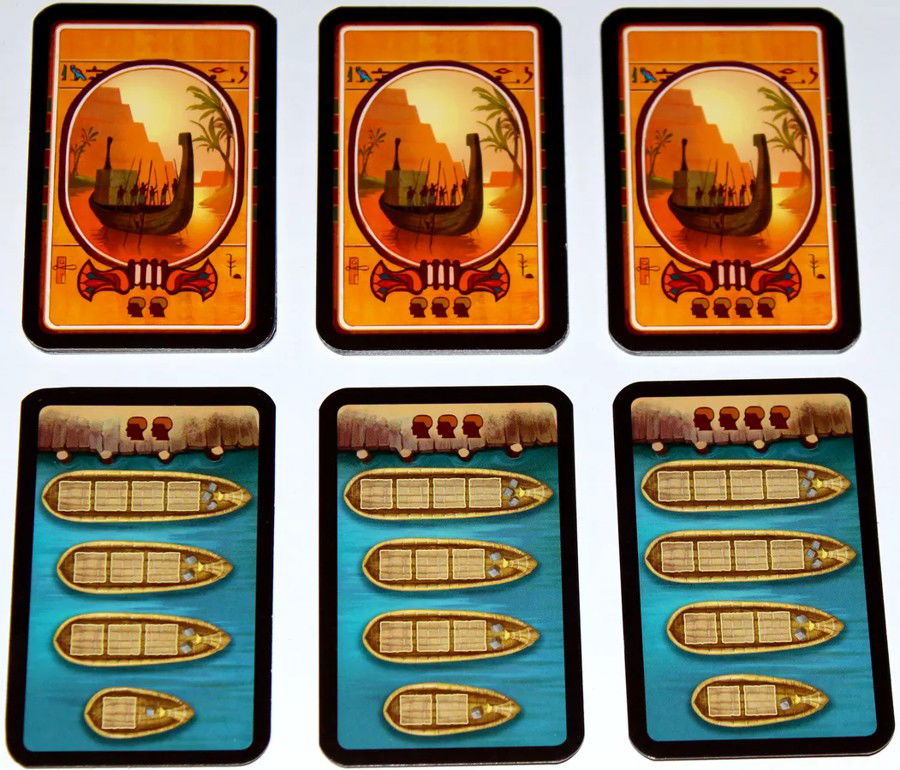
Based on this, during the setup, once the Round Card is drawn, you can start to outline your strategy. After all, the ships will determine your plans before the game even starts.
As for the actions, there are 4 different ones, and I'll say this: taking 3 stones from the quarry feels like a lost turn. After all, you didn't take stones to the ships, you didn't sail to a site, or played an action card. It's really frustrating, but necessary, because stones are your backbone. So, this action must be planned ahead, when your opponents also have few stones. That way, everyone will end up doing the same action for the round - or, at least, you hope they do.
The action of putting a stone from your sled into a ship is when you start to reveal your plans. There are 4 different ships, with varying capacities. Remember: the stones disembark in the order they were placed on the ship. Why is that important? In the Market, for example, the first ones to disembark also choose cards first. In other words, plan your strategy considering the position of your stone in the ship.
When sailing to one of the 5 sites, be thoughtful. If a player has several stones in the ship, be attentive to where they can score the most points. You can then sail that ship to another site and damage their strategy, but don't forget to also focus on the best for you, too. An important note: each site can only receive one ship per round.
Once you have some Blue Cards in hand, the game changes a lot. They are powerful, allowing you to place more than one stone or even take stones directly from the quarry to the boat. Whenever possible, have one of these cards available. Do not ignore the Blue Cards.
As for locations, the Market is not a priority, but it is where the Action Cards come from. So, even if you did not plan to go there, don't feel bad if you end up at the Market. The Pyramid gives you points immediately for each stone you contribute. The Temple, otherwise, scores points at the end of each round based on the visible stones from above - they are placed on top of each other.
The Burial Chamber scores points at the end of the game, considering same-color stones that are side by side. So, their position on the ship is important, because whoever gets off first places their stone first. The Obelisk, like the Burial Chamber, only scores points at the end of the game, but in a different way: here, what matters is the height of the Obelisk. It feels like a real race!
Finally, about the strategies: the Blue Cards have already been discussed a lot, they are extremely useful and sometimes allow you to perform 2 actions in a single turn. The Red Cards are for immediate use and can give you an unexpected advantage, and are always good options. The Green Cards score points based on the total number of stones in the sites. Therefore, encourage other players to place stones - or take the ship yourself! - to the sites where you can earn more points. Finally, Purple Cards are like collectible sets: the more you have, the more points you get at the end.
Honestly, Imhotep has so many variables that it's hard to pinpoint one straight path to victory - everything has an impact in the game, and you must be attentive. I would say that the strategies change with each available ship, each unoccupied site and according to the position of the stones on the ships!
Unboxing, Rules and Gameplay Videos
Unboxing:
Rules:
Gameplay:
Pedagogical Tips
Imhotep is both a history and a strategy lesson for your child. Your plans are constantly changing, not only because of your decisions, but also your opponents'. This is an excellent tool to incentivize attention, logical reasoning, and strategic thinking.
Get ready to teach your child to "change course" and rethink their plans with each action, because that's exactly what happens in Imhotep. There are many variables involved, and not all games allow for this kind of mental exercise. In some games, it's possible to form a strategy and stick to it until the end. In Imhotep, this is not the case. Your child's attention will be tested to the maximum.
This helps to develop an "adaptation" mindset: work with what you have, accept where the boats are going and adjust your plans accordingly. Also, it's a great opportunity to teach them about Ancient Egypt, its monuments and the fascinating history behind it all. Don't miss out on this chance.
Pedagogically, Imhotep teaches, stimulates and entertains!
I recommend Imhotep for your collection!!!








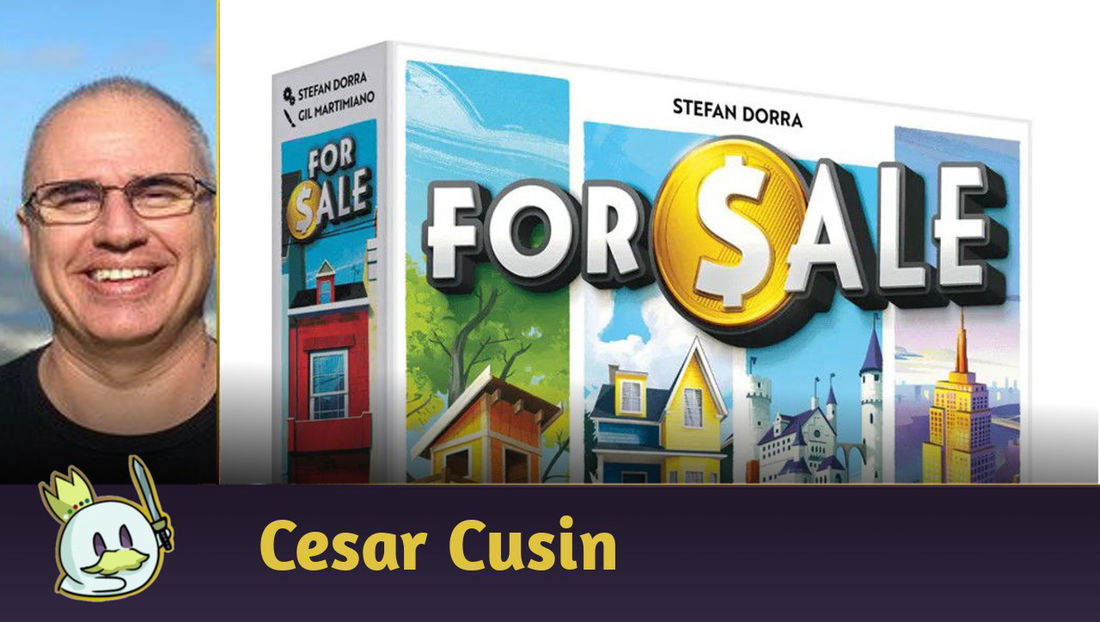




— Comentarios 0
, Reacciones 1
Se el primero en comentar